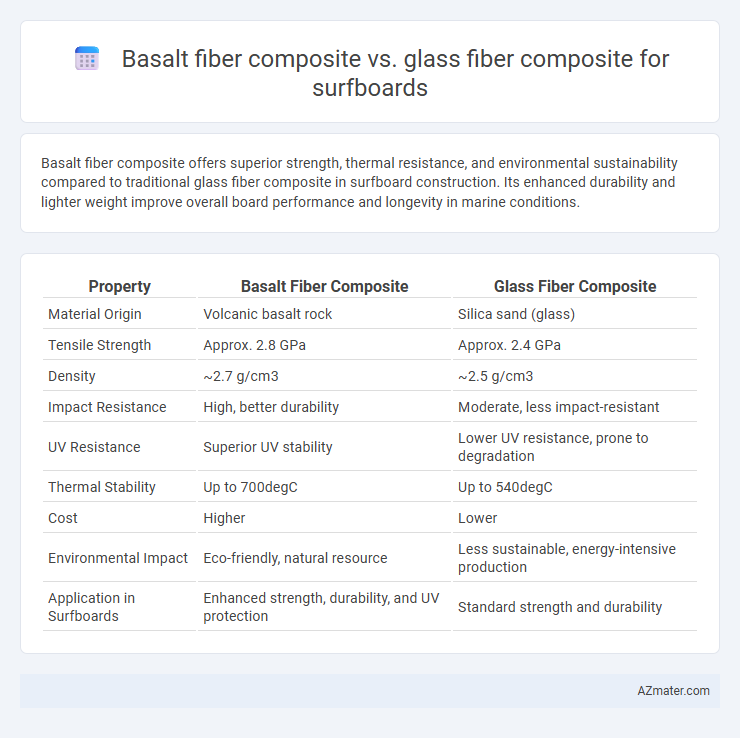Basalt fiber composite offers superior strength, thermal resistance, and environmental sustainability compared to traditional glass fiber composite in surfboard construction. Its enhanced durability and lighter weight improve overall board performance and longevity in marine conditions.
Table of Comparison
| Property | Basalt Fiber Composite | Glass Fiber Composite |
|---|---|---|
| Material Origin | Volcanic basalt rock | Silica sand (glass) |
| Tensile Strength | Approx. 2.8 GPa | Approx. 2.4 GPa |
| Density | ~2.7 g/cm3 | ~2.5 g/cm3 |
| Impact Resistance | High, better durability | Moderate, less impact-resistant |
| UV Resistance | Superior UV stability | Lower UV resistance, prone to degradation |
| Thermal Stability | Up to 700degC | Up to 540degC |
| Cost | Higher | Lower |
| Environmental Impact | Eco-friendly, natural resource | Less sustainable, energy-intensive production |
| Application in Surfboards | Enhanced strength, durability, and UV protection | Standard strength and durability |
Introduction to Fiber Composites in Surfboard Construction
Basalt fiber composites offer superior strength-to-weight ratios and enhanced durability compared to traditional glass fiber composites in surfboard construction. Basalt fibers are derived from volcanic rock, providing increased resistance to heat, UV radiation, and chemical corrosion, which extends the lifespan of surfboards. Glass fiber composites remain popular due to cost-effectiveness and ease of manufacturing but typically exhibit lower mechanical performance and environmental resistance than basalt fiber alternatives.
What is Basalt Fiber Composite?
Basalt fiber composite is made from natural basalt rock that is melted and spun into fibers, offering superior tensile strength, thermal stability, and resistance to corrosion compared to traditional glass fiber composites. In surfboard manufacturing, basalt fiber composites provide enhanced durability, lightweight properties, and better impact resistance, leading to longer-lasting and more performance-oriented boards. Unlike glass fiber, basalt fiber's natural mineral origin makes it an eco-friendlier option with improved mechanical properties ideal for high-performance aquatic sports equipment.
What is Glass Fiber Composite?
Glass fiber composite consists of fine glass fibers embedded in a resin matrix, commonly polyester or epoxy, providing high strength-to-weight ratio and excellent durability. It is widely used in surfboard manufacturing due to its resistance to impact, moisture, and UV damage, ensuring the board's longevity in harsh marine environments. Compared to basalt fiber composites, glass fiber composites are generally more cost-effective but slightly heavier, influencing the board's performance and maneuverability.
Material Properties: Basalt vs Glass Fiber
Basalt fiber composites offer higher tensile strength and superior impact resistance compared to glass fiber composites, providing enhanced durability for surfboards in rough water conditions. Basalt fibers exhibit better chemical resistance and thermal stability, reducing degradation from UV exposure and saltwater, which improves the lifespan of the surfboard. Glass fiber composites are lighter and more cost-effective but generally have lower mechanical performance and are more prone to damage under high-stress impacts.
Strength and Durability Comparison
Basalt fiber composites exhibit superior tensile strength and impact resistance compared to traditional glass fiber composites, making them more resilient under dynamic surfing conditions. The increased durability of basalt fibers provides enhanced resistance to environmental degradation such as UV exposure and saltwater corrosion, extending surfboard lifespan. These mechanical advantages translate into surfboards that maintain structural integrity and performance over time, offering a higher strength-to-weight ratio than glass fiber counterparts.
Weight and Flexibility in Surfboards
Basalt fiber composites offer lower density compared to traditional glass fiber composites, resulting in lighter surfboards that enhance maneuverability. The intrinsic stiffness of basalt fibers provides superior flexural strength, allowing surfboards to maintain optimal responsiveness and durability under dynamic wave conditions. This combination of reduced weight and increased flexibility makes basalt fiber composites a promising choice for high-performance surfboard construction.
Environmental Impact and Sustainability
Basalt fiber composites exhibit superior environmental sustainability compared to glass fiber composites due to their natural origin from volcanic rock, requiring less energy-intensive processing and offering greater recyclability. Basalt fibers produce lower CO2 emissions during manufacturing and contain no harmful chemicals, enhancing their eco-friendliness in surfboard production. Glass fiber composites rely on silica sand and involve higher energy consumption, resulting in greater environmental impact and challenges in recycling and disposal.
Performance on Water: Ride Quality and Control
Basalt fiber composites offer superior ride quality and control on water due to their higher tensile strength and stiffness compared to glass fiber composites, resulting in enhanced responsiveness and durability. The increased damping properties of basalt fibers reduce vibrations and improve stability, providing surfers with a smoother and more controlled experience in varying wave conditions. Glass fiber composites remain popular for their affordability and flexibility, but basalt fiber surfboards deliver a more performance-oriented ride with better energy transfer and board precision.
Cost and Accessibility Factors
Basalt fiber composites offer a cost-effective alternative to glass fiber composites for surfboards, with raw materials generally priced lower due to the abundant availability of basalt rock. While glass fiber composites benefit from widespread industrial use and established supply chains, basalt fiber's growing production infrastructure improves accessibility and reduces price volatility. Surfers seeking durable, eco-friendly boards may find basalt composites increasingly attractive as manufacturing scales up, balancing cost considerations with performance demands.
Choosing the Right Composite for Your Surfboard
Choosing the right composite for your surfboard depends on performance, durability, and environmental impact. Basalt fiber composite offers superior strength, higher resistance to corrosion, and better sustainability compared to traditional glass fiber composites, making it ideal for surfers seeking enhanced durability and eco-friendliness. Glass fiber composites remain popular for affordability and ease of repair, but basalt fiber's improved mechanical properties provide longer-lasting, high-performance boards suitable for various wave conditions.

Infographic: Basalt fiber composite vs Glass fiber composite for Surfboard
 azmater.com
azmater.com